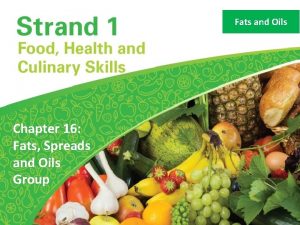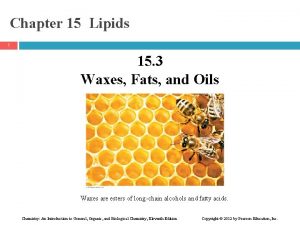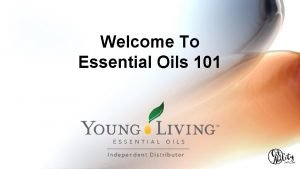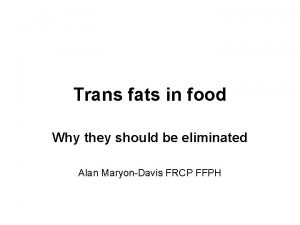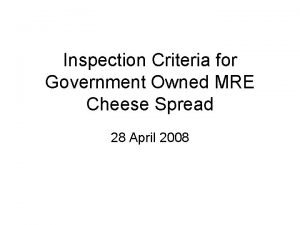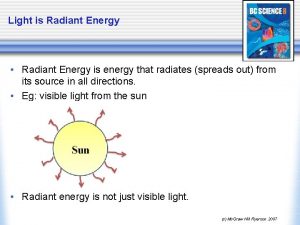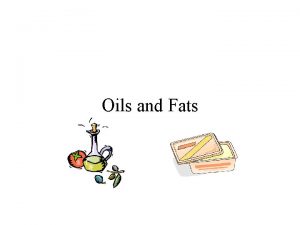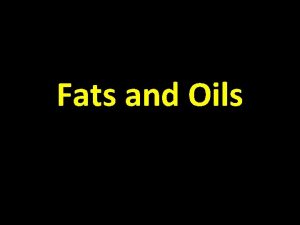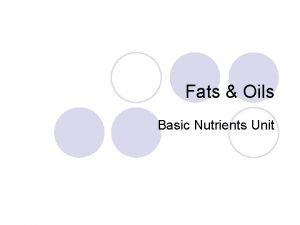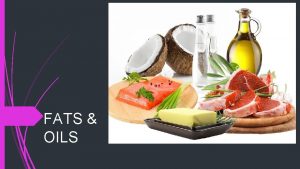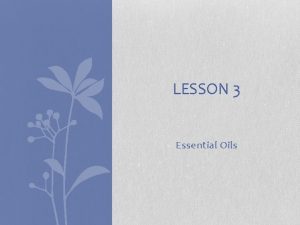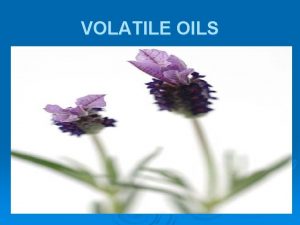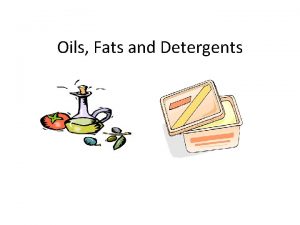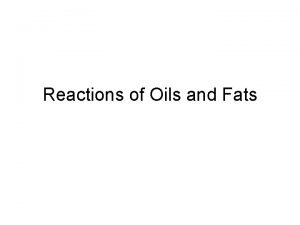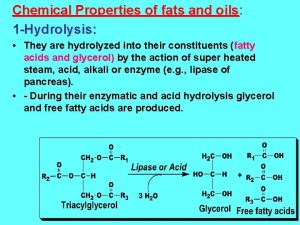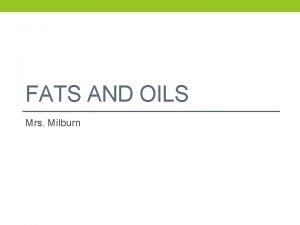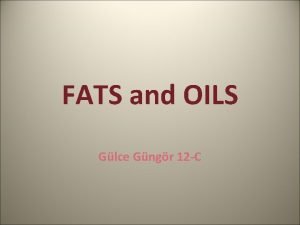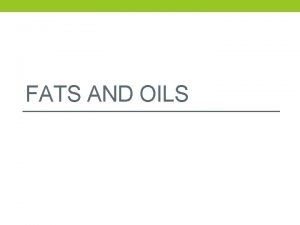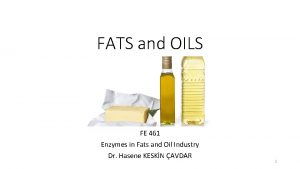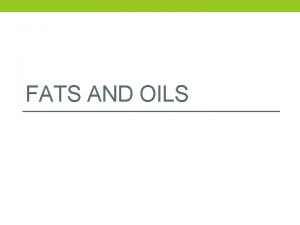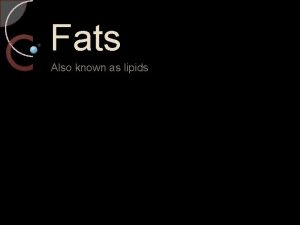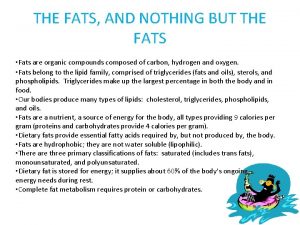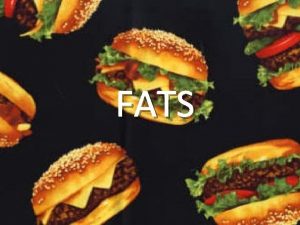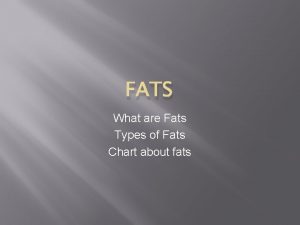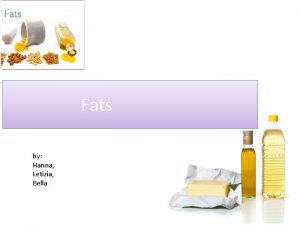Fats and Oils Chapter 16 Fats Spreads and

























- Slides: 25

Fats and Oils Chapter 16: Fats, Spreads and Oils Group

What I Will Learn • To classify fats and oils and give examples of each type • To outline the nutritive and dietetic value of fats, spreads and oils • To explain how fats and vegetable oils are processed • To compare and contrast dairy spreads • To state the guidelines for selecting, storing and cooking fats and oils • To list the uses of fats and oils in the diet

Class Activity Fat: Friend or Foe? • • Take your place on the opinion line – Friend, Unsure or Foe. Be prepared to defend your opinion. Listen to the arguments put forward by others in your class. Has your opinion changed? If so, move your position on the opinion line.

Fats, Spreads and Oils • Spreads and oils provide essential fats but these are only needed in very small amounts. Choose low-fat and reduced-fat spreads and oils such as rapeseed or olive oil instead of hard margarine, lard or butter. • Choose any two servings each day. • Mayonnaise and oil-based salad dressings also count towards your oil intake. Choose lower-fat options.

Fats, Spreads and Oils (continued) • Fats are solid at room temperature and oils are liquid at room temperature. • Visible fats can be clearly seen in or on food, e. g. butter, cream, fat on meat. • Other fats and oils are not clearly visible as they are combined with the food, e. g. fats in meat, cheese, eggs, milk and pastry.

Classification of Fats and Oils This is done according to their source and how saturated it is. Source Animal (saturated) Type • Suet is raw beef or mutton fat, found around the loins and kidneys; it is used in pastries, steamed puddings and mincemeat • Dripping is the fat melted from beef used for roasting and frying • Lard is pig fat used for roasting and frying • Dairy: Milk, cream, butter, yoghurts and cheese • Egg yolks used in mayonnaise

Classification of Fats and Oils (continued) Source Type Plant • Vegetable oils, e. g. maize, olive and soya beans (Unsaturated) • Nut oils, e. g. coconut, almond, walnut and peanut butter • Seed oils, e. g. sesame, sunflower and rapeseed • Margarine Marine • Oily fish, e. g. salmon and tuna (Unsaturated) • Fish liver oils, e. g. cod and halibut liver oils

Nutritive Value of Fats and Oils • Butter and margarine contain traces of proteins, while oils are usually lacking in them. • Fat varies depending on type, e. g. butter (82%), oils (99. 9%) and low-fat options (40%). • Carbohydrates are lacking in fats and oils. • Source of fat-soluble vitamins A, D, E and K. The amount varies depending on product, e. g. butter and dairy spreads contain traces of vitamin A and D, while margarine is fortified with them. • Trace amounts of calcium in butter and margarine. • The water content varies in proportion to fat content.

Dietetic Value of Fats and Oils • Provide a concentrated source of heat and energy and delay hunger because they stay in the stomach longer • Protect delicate organs, e. g. kidneys • Insulate the body in the form of adipose tissue and act as an energy reserve • Supply essential fatty acids and the fat-soluble vitamins A, D, E and K • Add flavour to food, e. g. in baking and salad dressings

What Affects our Choice of Fats and Oils? • A person’s health: The choice of fat/oil may depend on its saturated or unsaturated fat content, e. g. butter versus low -fat spread. • How you want to use it, e. g. how easy it is to spread for sandwiches or cream in baking. • Flavour: Used in salad dressings, e. g. olive or rapeseed oil. Butter is thought to have better flavour than margarine when used in cake-making.

Quick Recap Activity Do this quick revision sheet on fats and oils. See Activity 16. 3 in the TRB

Vegetable Oils Vegetable oils are obtained from a range of plants rich in oils, including: • Cereals, e. g. corn (maize) • Seeds, e. g. sesame, sunflower, rapeseed • Olives • Soya beans • Nuts, e. g. coconuts, almonds, peanuts and walnuts

How is Oil Processed? Oils can be hot pressed, e. g. olive oil or cold pressed, e. g. rapeseed oil. Hot-pressed oils Cold-pressed oils Plant material heated slightly (roasted) Squeezed when cold Extracts more oil Extracts less oil Bleached, filtered and odours removed No additives

Did You Know? Most good-quality oils are stored in coloured (green) glass bottles to keep them longer and filter out harmful ultraviolet (UV) rays.

Rapeseed Oil • Rapeseed oil is cold pressed so is more nutritious and contains half the saturated fat of olive oil, resulting in it being one of the healthiest culinary oils in the market. • It contains no artificial colours, flavours, or preservatives, and is a natural source of omega 3, -6, and -9 oils, which help to maintain normal cholesterol levels in the body, for a healthy heart and cardiovascular system.

Think-Pair-Share: Class Activity Cholesterol 1. Why are high cholesterol levels bad for you? 2. How can you reduce the risk of heart disease? 3. Many celebrity chefs are now promoting rapeseed oil in cooking. Why do you think it is so popular? 4. Find some recipes using rapeseed oil and share them with the rest of the group. See Activity 16. 5 in the TRB

Class Activity Watch the following You. Tube videos to learn more about how oil is made: How Vegetable Oil is made How Olive Oil is made

Margarine • Margarine was originally developed as a butter substitute. Manufacture is based on the principle of hydrogenation, i. e. converting liquid oils into solid fats by the addition of hydrogen gas. • It contains trans fat, which is considered by many doctors to be the worst type of fat you can eat. Unlike other dietary fats, trans fat, both raises ‘bad’ cholesterol and lowers ‘good’ cholesterol.

Margarine (continued) Block margarine Soft margarine • Made mainly from vegetable oils • Contains vegetable oils, but can contain marine and whey/buttermilk and water animal oils • High in saturated fat (but a little • High in saturated fat less than block margarine) • Foil/waxed paper wrapping • Packaged in plastic tubs Uses: Spreading, baking and frying

Dairy Spreads A wide range of dairy spreads and butters are available to consumers. These include: Dairy Spread Low-fat dairy spreads Description • Contains traces of protein • Fat (38– 40%) • Low in saturates and high in monounsaturates Examples Dairygold Lighter Avonmore Extra-light Kerry Low-Low

Dairy Spreads (continued) Dairy Spread Description Examples Spreadable low-fat butters • Protein (7%) • Fat (40%) • Higher in saturated fat Connaught Gold Half-Fat Functional Dairy Spreads • Has traces of protein • No hydrogenated fatty acids • Virtually no trans-fatty acids • Contains plant stanol esters Benecol, Flora Pro. Active

Uses of Fats and Oils • Spreading, e. g. on bread and crackers • Adds flavour to food, e. g. baking and salad dressing • Improves appearance of sauces, e. g. Alfredo sauce • Prevents sticking in cooking, e. g. shallow frying • Frying: Some vegetable oils are suitable for shallow and deep frying because of their high burning point, e. g. rapeseed oil has a high burning point of 240⁰C

Uses of Fats and Oils (continued) • Creates emulsions, e. g. mayonnaise • Shortens: Gives pastry a crumbly texture by inhibiting the formation of long protein strands • Acts as a preservative (anti-staling), e. g. improves shelf life of bread and cakes • Creaming, e. g. madeira and all-in-one mixtures

Class Activity Tasting session 1. Working in pairs, taste: a) Two spreads, one regular and one low fat, and a bread roll and/or b) Two oils, e. g. olive oil and rapeseed oil, and a bread roll 2. Fill out the worksheet you have been given and discuss the results as a class. See Activity 16. 5 in the TRB

Quick Revision 1. Classify fats and oils and give two examples of each type. 2. Discuss the nutritive and dietetic value of fats and oils. 3. Classify dairy spreads and give an example of each. 4. List the culinary uses of fats and oils, giving an example in each case.
 Fats spreads and oils
Fats spreads and oils Are lipids energy storage
Are lipids energy storage Chapter 15
Chapter 15 Difference between fats and oils in organic chemistry
Difference between fats and oils in organic chemistry What biomolecule transports substances in and out of cells
What biomolecule transports substances in and out of cells Non polar molecules that include fats oils and cholesterol
Non polar molecules that include fats oils and cholesterol The enlightenment spreads answer key
The enlightenment spreads answer key The enlightenment spreads
The enlightenment spreads Chapter 25 section 3 industrialization spreads
Chapter 25 section 3 industrialization spreads Chapter 9 section 3 industrialization spreads answer key
Chapter 9 section 3 industrialization spreads answer key Chapter 9 section 3 industrialization spreads answer key
Chapter 9 section 3 industrialization spreads answer key Chapter 6 section 3 the enlightenment spreads answer key
Chapter 6 section 3 the enlightenment spreads answer key Pharmaceutical application of volatile oils
Pharmaceutical application of volatile oils Volatile oils - pharmacognosy
Volatile oils - pharmacognosy Brian peskin
Brian peskin New age oils
New age oils Essential oils
Essential oils Carmen bove
Carmen bove Hydrogenation of oils
Hydrogenation of oils Owensboro grain edible oils
Owensboro grain edible oils Difference between spread and fillings
Difference between spread and fillings Trade spreads indian religions and culture
Trade spreads indian religions and culture Cheese spreads testing
Cheese spreads testing Innovation spreads by the process of
Innovation spreads by the process of Radiant energy
Radiant energy Understanding credit spreads
Understanding credit spreads
